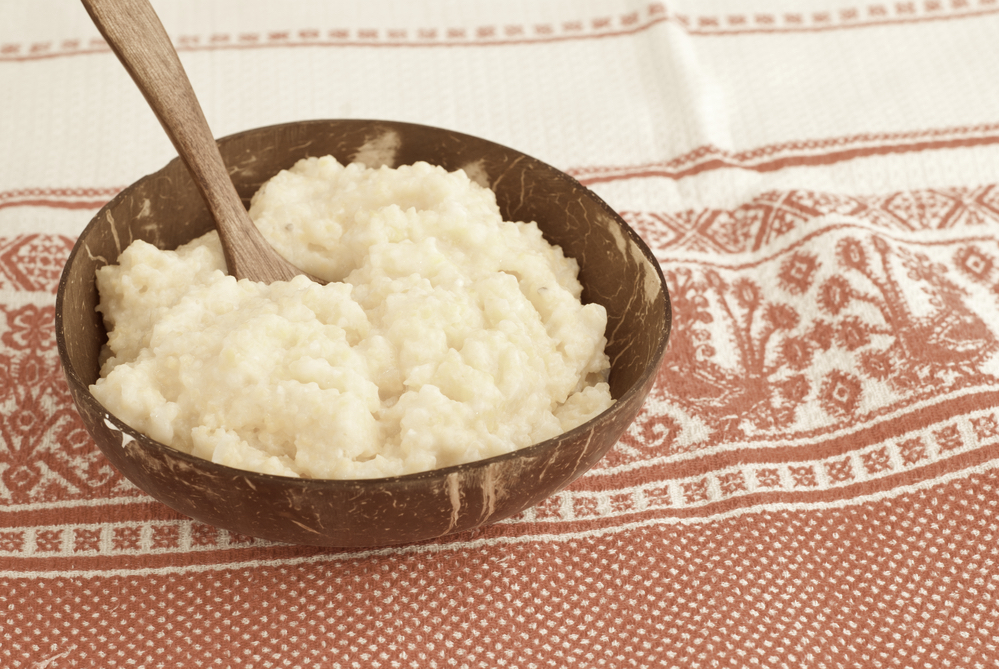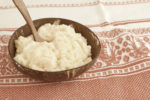
How to Make Mush and Porridge
Mush and porridge were cheap, nourishing meals in the 1800s, but the grains had to be cooked many hours. There were no instant hot cereal mixes like there are today. Mush and porridge were often cooked the night before in order to be ready for breakfast.
INFORMATION BELOW FROM 1800s COOKBOOKS
MUSH AND PORRIDGE
Mush is meal or grain cooked in water to the consistency of rather thin pudding. The most important point connected with the preparation of these is thoroughness in the cooking. The goodness of mush depends greatly on its being long and thoroughly boiled.
If sufficiency cooked, it is wholesome and nutritious, but exactly the reverse if made in haste. It is not too long to have it altogether three of four hours over the fire. Mushes are best cooked the day before they are needed, as long cooking improves rather than injures the grain.
All of these recipes may be made into porridges by following the rules given for mushes, except that a larger proportion of water should be used. Porridges are like mushes, only thinner.
OATMEAL MUSH
Put one-half cup oatmeal and one-half teaspoon salt into a double boiler and pour on one pint of boiling water. Place the upper vessel of the boiler on the stove, and boil two minutes. This effectually starts the cooking. Then put the upper vessel into the lower, and cook for five hours. The water in the under boiler should boil during this time, and will occasionally need replenishing. Serve the mush steaming hot with sugar and cream, and baked apples, applesauce, or tart jelly if one is fond of something acid.
RYE MUSH
To make smooth rye mush, sift a quart or more of rye meal into a pan, and gradually pour in sufficient cold water to make a very thick batter. Stir it hard with a spoon as you proceed, carefully pressing out all the lumps against the side of the pan. Add a very little salt. The batter must be so thick at the last that you can scarcely stir it. Then thin it with a little more water, and see that it is quite smooth. Rye, and also wheat flour have a disposition to be more lumpy than corn meal, when made into mush.
When thoroughly mixed and stirred, put it into a pot, place it over the fire, and boil it well, stirring it with a mush-stick till it comes to a hard boil. Then place it in a diminished heat, and simmer it slowly till you want to dish it up. Eat it warm, with butter and molasses, or with sweet milk, or fresh buttermilk. Rye mush is considered very wholesome, particularly in cases of dyspepsia.
HOMINY MUSH
Put one cup hominy, one teaspoon salt, and one and one-fourth cup water all together in a double boiler, and cook for three hours. Add more water if the mush seems stiff and thick. All preparations of corn absorb a great deal of liquid in cooking, and hominy usually needs a little more than four times its bulk. Hominy is exceedingly indigestible unless well cooked, but sweet and nutritious when subjected to a high temperature for a long time.
INDIAN MUSH
Have ready on a clear fire, a pot of boiling water. Stir into it, by degrees, (a handful at a time,) sufficient Indian meal* to make a very thick porridge, and then add a very small portion of salt, allowing not more than a level teaspoon to a quart of meal. You must keep the pot boiling all the time you are stirring in the meal. Between every handful, stir hard with the mush-stick, (a round stick about half a yard long, flattened at the lower end); if not well stirred, the mush will be lumpy.
After it is sufficiently thick and smooth, keep it boiling an hour longer, stirring it occasionally. Then cover the pot closely, and hang it higher up the chimney, or set it on hot coals on the hearth so as to simmer it slowly for another hour. The goodness and wholesomeness of mush depends greatly on its being long and thoroughly boiled. It should also be made very thick. If well made and well cooked, it is wholesome and nutritious. It is not too long to have it three or four hours over the fire, first boiling, and then simmering. The coarser the corn meal, the less cooking it requires.
Send it to the table hot and in a deep dish. Eat it with sweet milk, buttermilk, or cream. Or eat it with butter and sugar, or butter and molasses. Make a hole in the middle of your plate of mush, putting some butter into the hole, and then adding the sugar or molasses.
Cold mush that has been left may be cut into slices, or mouthfuls, and fried the next day in butter or in nice drippings of veal, beef, or pork; but not mutton or lamb.
*Indian meal – corn meal.
GRAHAM MUSH
Sift Graham meal* slowly into boiling salted water, stirring briskly until it is as thick as can be stirred with one hand. It will be improved by removing from the kettle to a pan, as soon as thoroughly mixed, and steaming three or four hours. Serve with milk or cream and sugar, or butter and syrup. It may also be eaten cold, or sliced and fried, like cornmeal mush.
*Graham meal – round wheat from which the bran has not been removed.
MUSH BREAD
Make a thin mush of cornmeal and milk (or hot water, if milk is scarce). Cook till perfectly done, stirring all the time to keep it smooth. Then add a good lump of butter, and after it cools a little, two eggs, one at a time. Beat in a very small pinch of soda and a little salt. Butter a baking dish and bake slowly till brown.
FRIED MUSHES
Mush left over from breakfast may be packed in a greased, one pound baking-powder box, and covered, which will prevent a crust from forming. The next morning, remove it from the box, slice thinly, dip in flour, and sauté.
Cook slowly, if preferred crisp and dry. Serve hot with maple syrup.
Image from Deposit Photos
=================================================
Do You Like Hot Breakfast Cereals? Please Leave a Comment Below.
=================================================
The First American Cookbook: A Facsimile of “American Cookery,” 1796
This facsimile of the first American-written cookbook published in the United States is not only a first in cookbook literature, but a historic document. It reveals the rich variety of food Colonial Americans enjoyed, their tastes, cooking and eating habits, even their colorful language.
Author Amelia Simmons worked as a domestic in Colonial America and gathered her cookery expertise from firsthand experience.
=================================================


5 thoughts on “How to Make Mush and Porridge”
I grew up with cornmeal mush as a regular breakfast family favorite. It was one of the things that my Bulgarian grandfather always loved with honey. I don’t have it very often these days….
I’ve had grits and oatmeal, but mostly we had cold cereal for breakfast when I was a child.
I grew up eating fried mush! To this day I am still making mush. Just made a bread pan of it! Not many people I ask eat it and figure kids don’t even know what it is. Also I like pudding meat on pancakes! Also have a mush recipe with pork in it called scrabble.
The term mush doesn’t sound very appealing but some of these recipes actually do. Interesting.
I never cared for warm cereals, but I bet I would if I lived in the 1800s because there wouldn’t be so many food choices.